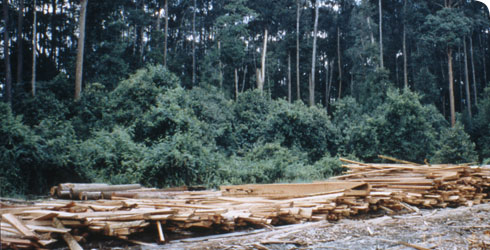What threatens our biodiversity?
The world's biodiversity is under threat from various dangers, the majority of which have been caused by humans.
Habitat loss and fragmentation
Conservation biologists consider habitat loss and fragmentation to be the main cause of biodiversity loss.
Clearance of native vegetation for agriculture, housing, timber and industry, as well as draining wetlands and flooding valleys to form reservoirs, destroys these habitats and all the organisms in them.
This destruction can also cause remaining habitats to become fragmented and so too small to support some species. Fragments may be too far apart for organisms to move between.
Invasive alien species
Invasive alien species are the 2nd greatest threat to biodiversity worldwide.
Whether introduced on purpose or accidentally, non-native species can cause severe problems in the ecosystems they invade, from affecting individuals to causing huge changes in ecosystem functioning and the extinction of many species.
This problem will probably get worse during the next century driven by climate change, and an increase in global trade and tourism.
As well as the risks to human health, alien species inflict massive economic costs to agriculture, forestry, and fisheries.
Pollution
Pollution is currently poisoning all forms of life, both on land and in the water, and contributing to climate change. Any chemical in the wrong place or at the wrong concentration can be considered a pollutant.
Transport, industry, construction, extraction, power generation and agroforestry all contribute pollutants to the air, land and water. These chemicals can directly affect biodiversity or lead to chemical imbalances in the environment that ultimately kill individuals, species and habitats.
Climate change
Climate change, brought about by emissions of greenhouse gases when fossil fuels are burnt, is making life uncomfortably hot for some species and uncomfortably cold for others.
This can lead to a change in the abundance and distribution of individual species around the globe and will affect the crops we grow, cause a rise in sea levels and problems to many coastal ecosystems. In addition, the climate is becoming more unpredictable and extreme devastating events are becoming more frequent.
Over exploitation
Over exploitation by humans causes massive destruction to natural ecosystems.
Exploitation of biodiversity occurs for food (e.g. fish), construction (e.g. trees), industrial products (e.g. animal blubber and skins), the pet trade (e.g. reptiles, fish and orchids), fashion (e.g. fur and ivory) and traditional medicines (e.g. rhino horn).
Selective removal of an individual species can unbalance ecosystems and all other organisms within them. In addition, the physical removal of one species often harms other (e.g. fishing by-catches).
Human populations
Human populations are growing at an exponential rate, resulting in the problems above. There are more than 7 billion people in the world and the population just keeps growing. Human population numbers tripled in the 20th century and, although growth is slowing, one estimate predicts it will take until the 23rd century for them to level out at around 11 billion.

